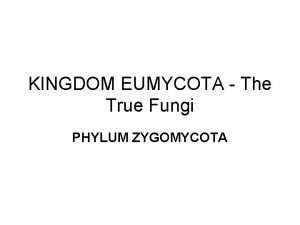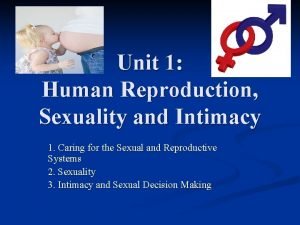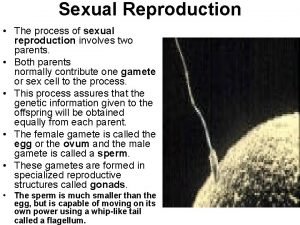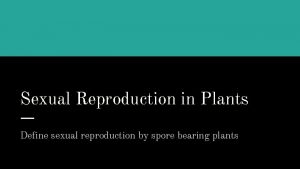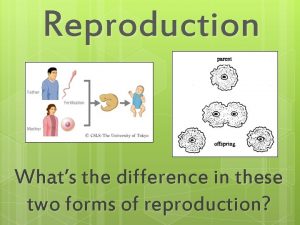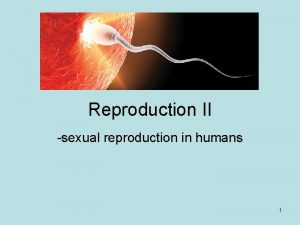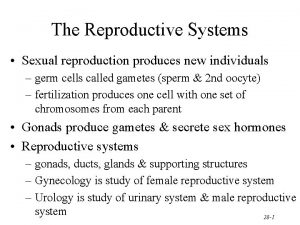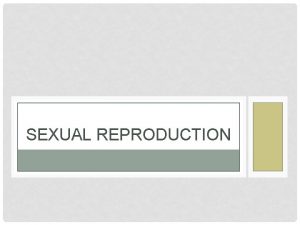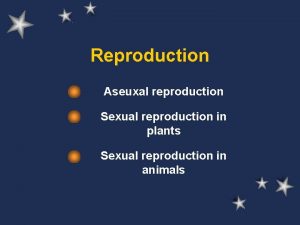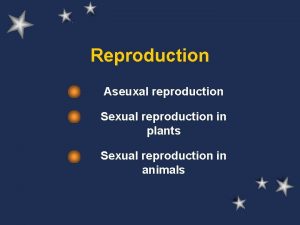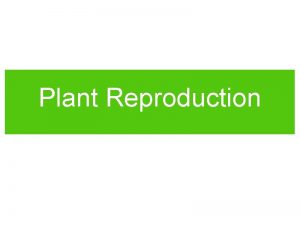The Reproductive Systems Sexual reproduction produces new individuals












- Slides: 12

The Reproductive Systems • Sexual reproduction produces new individuals – germ cells called gametes (sperm & 2 nd oocyte) – fertilization produces one cell with one set of chromosomes from each parent • Gonads produce gametes & secrete sex hormones • Reproductive systems – gonads, ducts, glands & supporting structures – Gynecology is study of female reproductive system – Urology is study of urinary system & male reproductive system

Chromosomes in Somatic Cells & Gametes • Somatic cells (diploid cells) – 23 pairs of chromosomes for a total of 46 • each pair is homologous since contain similar genes in same order • one member of each pair is from each parent – 22 autosomes & 1 pair of sex chromosomes • sex chromosomes are either X or Y • females have two X chromosomes • males have an X and a smaller Y chromosome • Gametes (haploid cells) – single set of chromosomes for a total of 23 – produced by special type of division: meiosis

Male Reproductive System • Gonads, ducts, sex glands & supporting structures • Semen contains sperm plus glandular secretions

Formation of Spermatogenesis is formation of sperm cells from spermatogonia.

Supporting Cells of Sperm Formation • Sertoli cells -- extend from basement membrane to lumen – form blood-testis barrier – support developing sperm cells – produce fluid & control release of sperm into lumen

Spermatogenesis

Hormonal Control of Spermatogenesis • Puberty – hypothalamus increases its stimulation of anterior pituitary with releasing hormones – anterior pituitary increases secretion LH & FSH • LH stimulates Leydig cells to secrete testosterone – an enzyme in prostate & seminal vesicles converts testosterone into dihydrotestosterone (DHT-more potent) • FSH stimulates spermatogenesis – with testosterone, stimulates sertoli cells to secrete androgen-binding protein (keeps hormones levels high) – testosterone stimulates final steps spermatogenesis

Hormonal Effects of Testosterone • Testosterone & DHT bind to receptors in cell nucleus & change genetic activity • Prenatal effect is born a male • At puberty, final development of 2 nd sexual characteristics and adult reproductive system – sexual behavior & libido – male metabolism (bone & muscle mass heavier) – deepening of the voice

Semen • Mixture of sperm & seminal fluid – glandular secretions and fluid of seminiferous tubules – slightly alkaline, milky appearance, sticky – contains nutrients, clotting proteins & antibiotic seminalplasmin • Typical ejaculate is 2. 5 to 5 ml in volume • Normal sperm count is 50 to 150 million/ml – actions of many are needed for one to enter • Coagulates within 5 minutes -- reliquefies in 15 due to enzymes produced by the prostate gland • Semen analysis----bad news if show lack of forward motility, low count or abnormal shapes

Cross-Section of Penis • Corpora cavernosa – upper paired, erectile tissue masses – begins as crura of the penis attached to the ischial & pubic rami and covered by ischiocavernosus muscle • Corpus spongiosum – lower erectile tissue mass – surrounds urethra – begins as bulb of penis covered by bulbospongiosus muscle – ends as glans penis

Root of Penis & Muscles of Ejaculation • Bulb of penis or base of corpus spongiosum enclosed by bulbospongiosus muscle • Crura of penis or ends of corpora cavernosa enclosed by ischiocavernosus muscle

Erection & Ejaculation • Erection – sexual stimulation dilates the arteries supplying the penis – blood enters the penis compressing the veins so that the blood is trapped. – parasympathetic reflex causes erection • Ejaculation – muscle contractions close sphincter at base of bladder and move fluids through ductus deferens, seminal vesicles, & ejaculatory ducts – ischiocavernous & bulbospongiosus complete the job
 Sexual and asexual reproduction venn diagram
Sexual and asexual reproduction venn diagram Sexual reproduction and asexual reproduction
Sexual reproduction and asexual reproduction Venn diagram of sexual and asexual reproduction in animals
Venn diagram of sexual and asexual reproduction in animals Where semen is stored
Where semen is stored Phylum eumycophyta
Phylum eumycophyta Domain eukarya kingdom fungi
Domain eukarya kingdom fungi A sexual reproduction in humans
A sexual reproduction in humans Chapter 20 sexual reproduction in animals packet answers
Chapter 20 sexual reproduction in animals packet answers A sexual reproduction involves
A sexual reproduction involves Define sexual reproduction
Define sexual reproduction Sexual reproduction and genetics section 1 meiosis
Sexual reproduction and genetics section 1 meiosis Whats sexual reproduction
Whats sexual reproduction A sexual reproduction in humans
A sexual reproduction in humans




